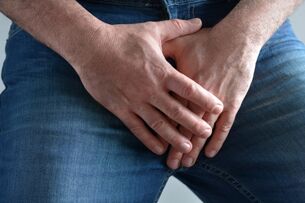
Prostatitis, like any other disease, manifests itself by certain symptoms. It is important for a man to know exactly the first signs, because they are signs for further examination and examination. We will talk about different forms of prostatitis and the first aid measures manifested in the article.
Outline of Prostate and Prostatitis
An adult male's prostate gland is a glandular organ consisting of two lobules and a follicle, as well as the adjoining prostate urethra. The prostate gland performs 3 functions at once:
- Adjust semen density by producing water from the prostate gland and diluting ejaculate with it.
- Blocking the urethra at the time of orgasm.
- Involved in the production of certain hormones or controlling their levels in the body.
If a man's reproductive system fails, the first signs will be related to these functions of the prostate gland.
Due to the entry of pathogenic microflora into the prostate or after an injury, hypothermia, as well as a delayed process, inflammation begins. In this case, blood microcirculation is disturbed, the outflow of lymph, venous blood and prostate secretions deteriorate. This leads to the development of edema and an increase in glandular size. As a result, the tissues are compressed, the man has an episiotomy or slight pain in the lower abdomen - the first sign of imminent prostatitis.
The clinical picture will largely depend on the type of inflammatory process and the reason it causes it.
Symptoms of acute bacterial prostatitis
It is very difficult to overlook the first symptoms of acute prostatitis - they come on suddenly and grow rapidly. Usually 2 to 4 days have passed from the onset of the inflammatory process and the first sign. In this case, the clinical picture will depend on the stage of the disease.
In this case, the clinical picture will depend on the stage of the disease.
Acute catarrhal inflammation
The first sign of this type of prostatitis will be a feeling of heaviness in the perineum, as well as more urinating at night. Body temperature does not increase with this form, because men often ignore existing problems or try to solve them on their own, thereby provoking the next stage.
Acute folliculitis
At this stage, the first signs of prostatitis will be clearer. Many men no longer take the risk of buying medicine themselves and go to the doctor. Complaints will vary widely:
- Dull pain in the perineum, which may spread to the tailbone or anus.
- Painful urination, difficult man may mean acute urinary retention.
- Pain with a bowel movement, so the man cannot go to the toilet.
These are the first symptoms of cystic acute prostatitis, in addition to fever of up to 38 degrees, general weakness, weakness, coma. A man becomes irritable, libido decreases, erectile dysfunction may appear.
These symptoms persist and if not treated properly, the next stage develops.
Acute parenchymal inflammation
The inflammatory process has spread to the parenchyma, so it is growing rapidly. The first thing that the patient can notice is the increase in body temperature to high values (from 39 ° C), chills, and dry mouth. The pain will become intense, throbbing, and can be felt in the perineum and lower back, abdomen, genitals.
Peeing will also change. First, a man will notice an interrupted flow, and then he will not be able to empty his bladder due to the intense pain. If you do not call an ambulance, there will be signs of indigestion - bloating, constipation, and abdominal pain in different locations. Fetid mucus is excreted from the anus.
You can understand that acute parenchymal prostatitis started by its characteristic feature: the pain is lessened if you lie on your back and raise your legs. This is a clear signal that urgent medical attention is needed.
The first signs of chronic prostatitis

Chronic prostatitis is a long-lasting inflammation in the prostate gland, so the first signs that start are usually in an acute form. However, men over time expect more severe episodes, and here you need to understand what symptoms they will accompany. Usually, men complain about the following health problems:
- Burning around the foreskin of the penis, especially during ejaculation or urination;
- Mild pain in the perineum, possibly spreading to the pubic;
- A slight increase in body temperature.
With chronic prostatitis, erection problems inevitably begin, as does a child's ability to participate in conception. This is because the prostate function is impaired, so the blood supply to the penis changes, sperm quality also decreases.
At the first signs of an exacerbation of prostatitis, you need to go through a course of treatment. It is not recommended to use drugs previously prescribed by a doctor without preliminary examination.
Clinical image of the disease
Regardless of the form of the inflammatory process and the reason it causes it, a man will have a noticeable trio of symptoms, with the difference only in the degree of their manifestation. Prostatitis is always accompanied by difficulty urinating, pain and erectile dysfunction.
Urine with prostatitis is excreted in droplets or in intermittent flow. Sometimes jets are sprayed out and then it is problematic for a man to relieve the small need while standing. The urge to urinate occurs more often at night, especially near morning. With stones in the prostate gland, the urine may turn pink due to impurities in the blood.

With prostatitis, epithelium and other cells accumulate in the urethra and bacteria can also multiply. This results in a more intense burning sensation when urinating or ejaculating.
Pain was inevitable. Depending on the severity of the pathological process, they can be:
Whine- ;
- stupid; Shoot
- (pulse).
Their most common location is the perineum, just below the testicles. Irradiation to coccyx, sacrum, pubic, penis is not excluded. In addition, pain can occur in the anus, especially when pushing, as men often experience constipation.
As for body temperature, it rarely goes up to 38 degrees. The exception is parenchymal and purulent prostatitis, in which this index can reach up to 40 degrees and is accompanied by chills, severe depression, and sometimes confusion. In such cases, temperature with inflammatory prostatitis is life-threatening for the patient.
First aid for prostatitis
It is possible to treat prostatitis on an outpatient basis, if we are not talking about purulent processes. But even in this case, one cannot do without going to a doctor for a referral to examine and choose treatment strategies. However, the first signs of prostatitis can appear when a man cannot call an ambulance, so you need to know some first aid rules.

- When the temperature rises above 38 degrees, you can take fever-reducing medicine.
- For pain relief, it is best to lie on your back and raise your legs as high as possible (against the wall or furniture).
- For particularly severe pain you can take an antispasmodic or order a suppository.
You need to see your doctor as soon as possible, at the front desk you will need to tell you which medicine you have taken and how much dose you have.
Traditional methods can be used only after confirming the diagnosis and only with the permission of the attending physician.
How does prostatitis manifest in the analyzes
Prostatitis refers to diseases asymptomatic only present in them. For example, the burning sensation when urinating may be caused by urethritis, and pain in the lower abdomen could be due to appendicitis or cystitis. Therefore, final diagnosis is not made on the basis of patient complaints, but on the results of tests of blood, urine, semen and prostate secretions. Data of rectal examination, TRUS and a number of other instrumental methods were also taken into account.
The following diagnostic features are characteristic of prostatitis:
- Presence of bacteria or fungus in the urine and prostate fluid.
- Presence of white blood cells in the urine and blood test.
- Reduces the number of leukocytes in the context of an increase in the number of leukocytes in the secretion of the prostate gland;
- Blood in urine or semen;
- Reduces erythrocyte sedimentation rate in blood tests.
- Prostate pain when palpable, change in its size and consistency.
- Changes the reverb, graininess, contour based on the TRUS result.
The combination of these signs and complaints about health conditions allows us to make an accurate diagnosis, which means that the correct treatment will be indicated. The patient's quality of life, the patient's rate of recovery, and in some cases the patient's life depends on this.
Conclusion
Knowing the first signs of prostatitis in men, you can promptly navigate changes in your health condition and take action first. If an episiotomy begins, the urine flow becomes scarce and the urge to urinate becomes more frequent - this is reason to suspect an inflamed prostate and is a sign to seek medical attention. It is better not to self-medicate in these cases.
























